Renewable energy policies in the US are designed to promote the adoption of clean energy sources through a framework of standards, incentives, and regulations. These initiatives aim to lower greenhouse gas emissions, enhance energy security, and foster economic growth within the renewable sector. Financial incentives such as tax credits and grants play a crucial role in making renewable technologies more accessible, while compliance requirements ensure that energy producers meet necessary environmental and operational standards.
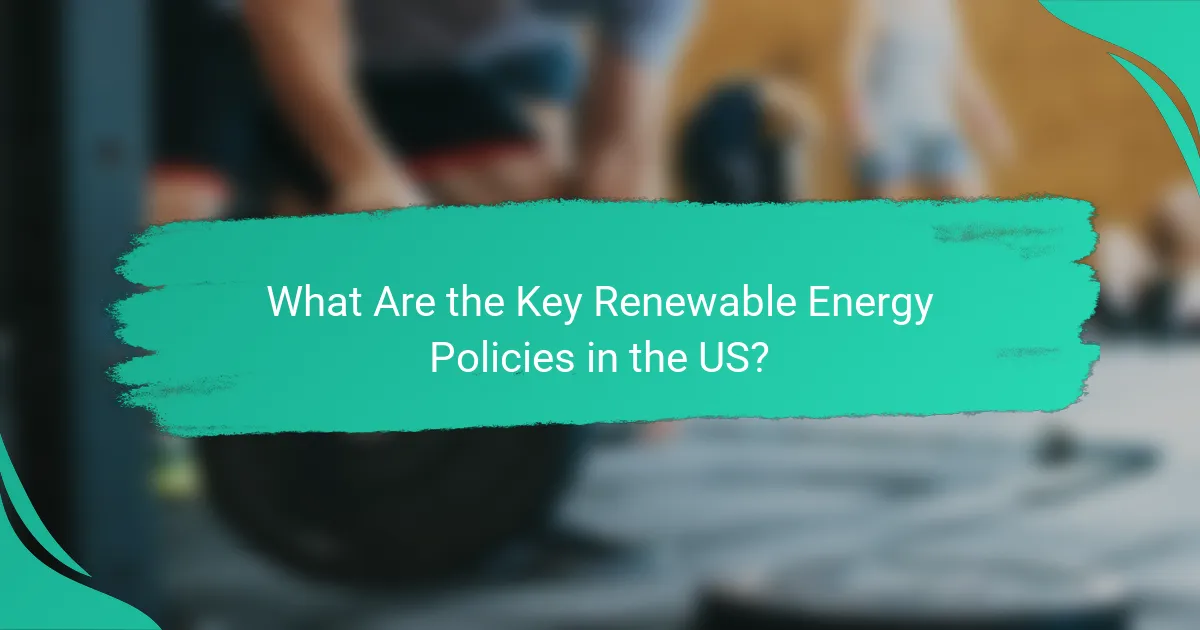
What Are the Key Renewable Energy Policies in the US?
The key renewable energy policies in the US focus on promoting the use of clean energy sources through various standards, incentives, and regulations. These policies aim to reduce greenhouse gas emissions, enhance energy security, and stimulate economic growth in the renewable sector.
Federal Renewable Portfolio Standards
Federal Renewable Portfolio Standards (RPS) set mandatory targets for the percentage of energy that utilities must source from renewable resources. These standards vary by state, but they collectively aim to increase the share of renewables in the national energy mix, driving investment in technologies like wind and solar.
Utilities that fail to meet RPS requirements may face penalties, which incentivizes compliance. The federal government also supports states in developing their own RPS frameworks, allowing for flexibility based on local resources and energy needs.
State-Level Incentives
State-level incentives for renewable energy include grants, rebates, and performance-based incentives designed to encourage the adoption of clean energy technologies. These incentives can significantly lower the upfront costs for consumers and businesses investing in solar panels, wind turbines, and other renewable systems.
For example, states like California and New York offer substantial financial support for residential solar installations, which can cover a significant portion of installation costs. Each state’s incentive structure varies, so it’s essential to research local programs to maximize benefits.
Tax Credits and Deductions
Tax credits and deductions are crucial tools for promoting renewable energy investment in the US. The federal government provides various tax incentives, such as the Renewable Energy Production Tax Credit (PTC) and the Investment Tax Credit (ITC), which can substantially reduce the tax burden for renewable energy projects.
These credits can cover a significant percentage of project costs, making them attractive for investors. It’s important to stay updated on the expiration dates and eligibility criteria for these credits, as they can change based on federal policy shifts.
Clean Power Plan
The Clean Power Plan was designed to reduce carbon emissions from power plants, promoting a shift towards cleaner energy sources. Although its implementation has faced legal challenges, it set ambitious goals for states to lower emissions and increase renewable energy use.
States were encouraged to develop their own plans to meet these targets, which could include expanding renewable energy generation and improving energy efficiency. Understanding the implications of the Clean Power Plan is essential for stakeholders in the energy sector, as it shapes regulatory frameworks and investment strategies.
Investment Tax Credit (ITC)
The Investment Tax Credit (ITC) allows investors to deduct a significant percentage of the cost of installing renewable energy systems from their federal taxes. This credit has been a driving force behind the growth of solar energy in the US, making it financially viable for many projects.
Currently, the ITC offers a credit of around 26% for solar installations, but this rate is set to decrease in the coming years. Investors should plan accordingly to take advantage of the current rates before they decline, ensuring that projects are completed in a timely manner to maximize benefits.
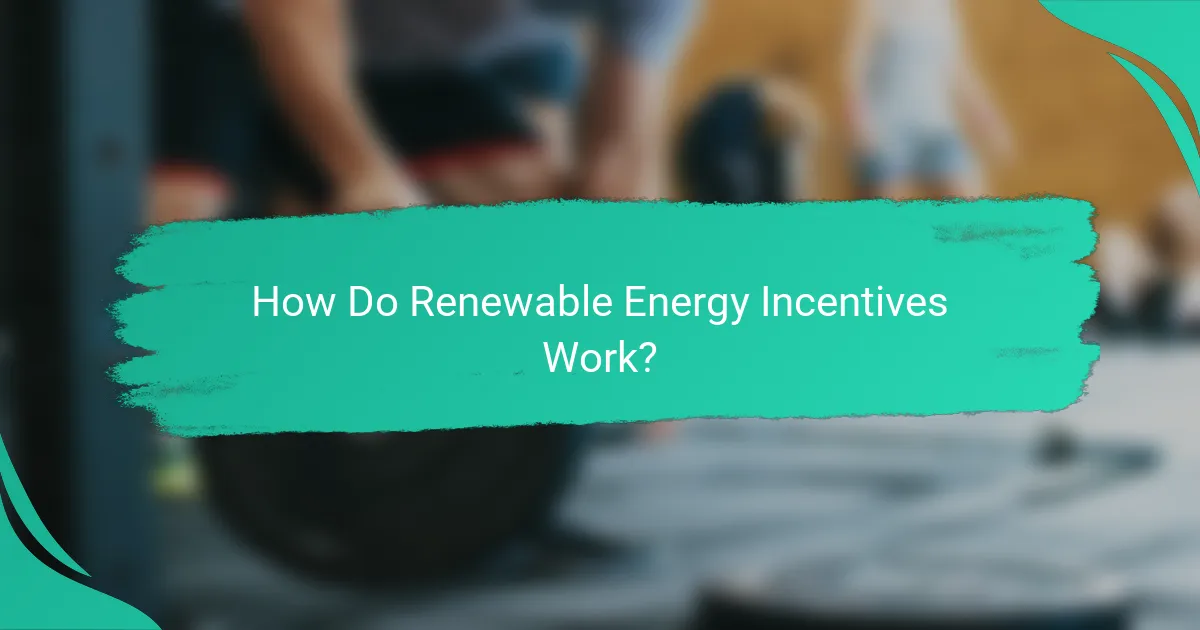
How Do Renewable Energy Incentives Work?
Renewable energy incentives are financial benefits designed to encourage the adoption of clean energy technologies. These incentives can take various forms, including tax credits, grants, and subsidies, which help reduce the initial costs of renewable energy systems for both individuals and businesses.
Financial Incentives for Homeowners
Homeowners can benefit from several financial incentives when installing renewable energy systems, such as solar panels or wind turbines. Tax credits, like the Investment Tax Credit (ITC) in the U.S., allow homeowners to deduct a significant percentage of the installation costs from their federal taxes.
Additionally, some states offer rebates or performance-based incentives that pay homeowners for the energy produced by their systems. It’s essential to research local programs, as benefits can vary widely by region.
Corporate Tax Benefits
Corporations investing in renewable energy can access various tax benefits that significantly lower their financial burden. For instance, businesses may qualify for the Production Tax Credit (PTC), which provides a per-kilowatt-hour tax credit for electricity generated from renewable sources.
Moreover, companies can often deduct the costs of renewable energy installations from their taxable income, enhancing cash flow. Understanding the specific tax regulations in their country or state is crucial for maximizing these benefits.
Grants and Subsidies
Grants and subsidies are direct financial contributions from government entities aimed at promoting renewable energy projects. These funds can cover a portion of the installation costs, making it more feasible for both individuals and businesses to invest in clean energy solutions.
Many countries and local governments have specific programs that provide grants for renewable energy initiatives. Applicants should check eligibility requirements and deadlines to ensure they can take advantage of these opportunities effectively.
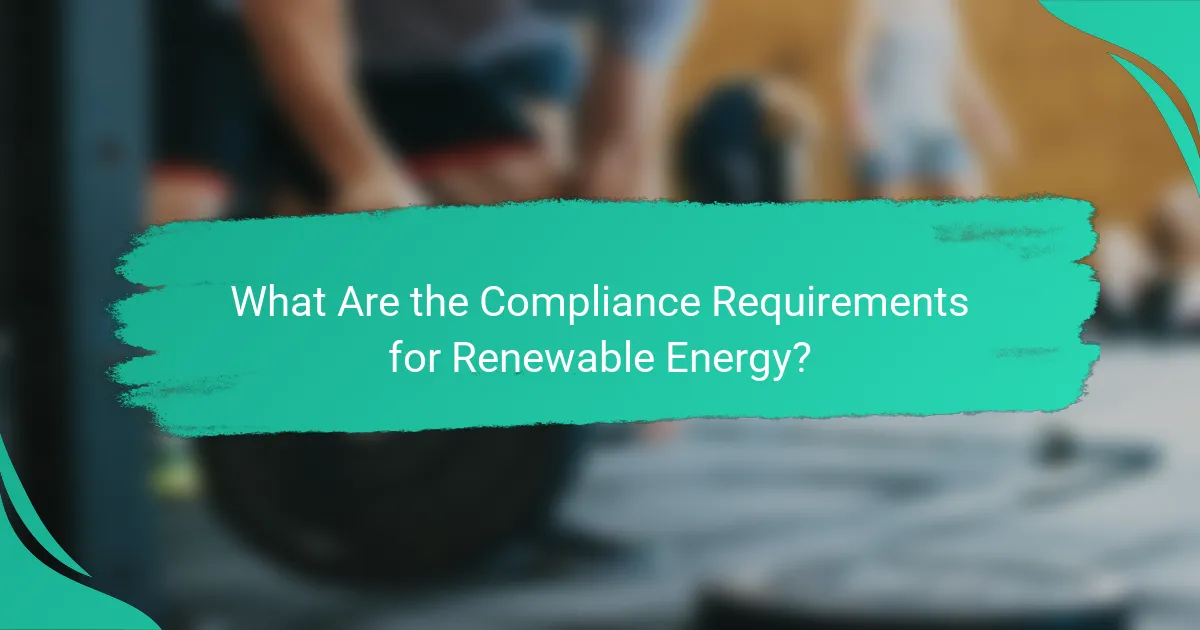
What Are the Compliance Requirements for Renewable Energy?
Compliance requirements for renewable energy involve adhering to specific regulations and standards set by government bodies to ensure that energy producers meet environmental and operational benchmarks. These requirements typically include reporting, monitoring, and certification processes that vary by region and energy type.
Reporting and Monitoring Obligations
Entities involved in renewable energy production must regularly report their energy output and operational data to regulatory authorities. This often includes submitting detailed reports on energy generation, emissions, and resource usage, typically on a quarterly or annual basis.
Monitoring obligations may require the installation of metering equipment to track energy production accurately. For instance, solar farms might need to use performance monitoring systems to ensure compliance with local standards.
Penalties for Non-Compliance
Failure to meet compliance requirements can result in significant penalties, including fines or the revocation of operating licenses. These penalties can vary widely, with fines often ranging from hundreds to thousands of dollars, depending on the severity of the violation.
In some cases, non-compliance may also lead to increased scrutiny from regulators, which can complicate future operations and project approvals. It is crucial for renewable energy producers to stay informed about their obligations to avoid these repercussions.
Certification Processes
Certification processes for renewable energy projects typically involve third-party verification to ensure compliance with established standards. This may include obtaining certifications like LEED for buildings or specific renewable energy certificates (RECs) that validate the environmental benefits of the energy produced.
To achieve certification, projects often need to undergo rigorous assessments, which can include site inspections and documentation reviews. It is advisable for developers to engage with certification bodies early in the project development phase to streamline the process and address any potential issues proactively.
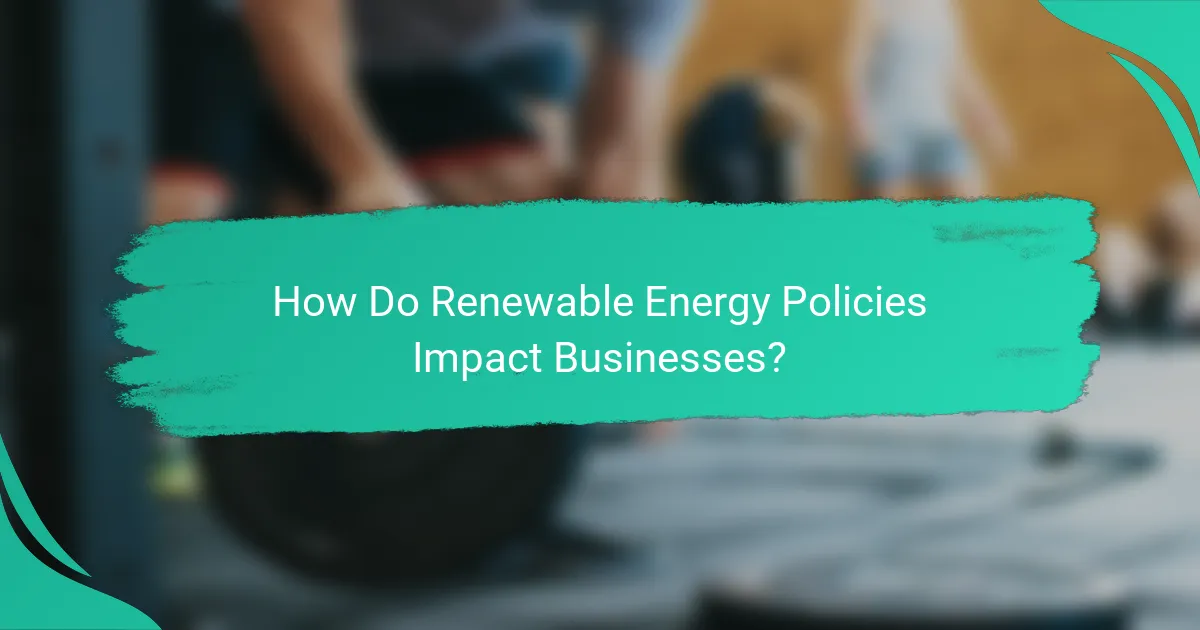
How Do Renewable Energy Policies Impact Businesses?
Renewable energy policies significantly influence businesses by shaping operational costs, investment opportunities, and competitive dynamics. These policies can lead to lower energy expenses, encourage innovation in clean technologies, and enhance a company’s market position.
Cost Reductions for Energy-Intensive Industries
Energy-intensive industries, such as manufacturing and transportation, can benefit from renewable energy policies through reduced energy costs. By transitioning to renewable sources like solar or wind, these businesses can lower their dependence on fossil fuels, which are subject to volatile pricing.
In many regions, government incentives such as tax credits or grants can further decrease the initial investment required for renewable energy systems. For instance, companies may find that their energy costs drop by 20-30% after implementing solar panels, significantly impacting their bottom line.
Increased Investment in Clean Technologies
Renewable energy policies often stimulate increased investment in clean technologies. Governments may offer financial incentives or subsidies to businesses that adopt sustainable practices, making it more attractive for companies to invest in innovative solutions.
For example, businesses that develop energy-efficient products or systems can access funding through various programs aimed at promoting sustainability. This not only helps in reducing operational costs but also positions companies as leaders in the growing green economy.
Market Competitiveness
Adopting renewable energy can enhance a company’s market competitiveness by improving its sustainability profile. As consumers increasingly prefer environmentally responsible brands, businesses that prioritize renewable energy can differentiate themselves in the marketplace.
Moreover, companies that invest in clean energy technologies may gain a first-mover advantage, allowing them to capture market share before competitors catch up. This proactive approach can lead to long-term profitability and brand loyalty among eco-conscious consumers.
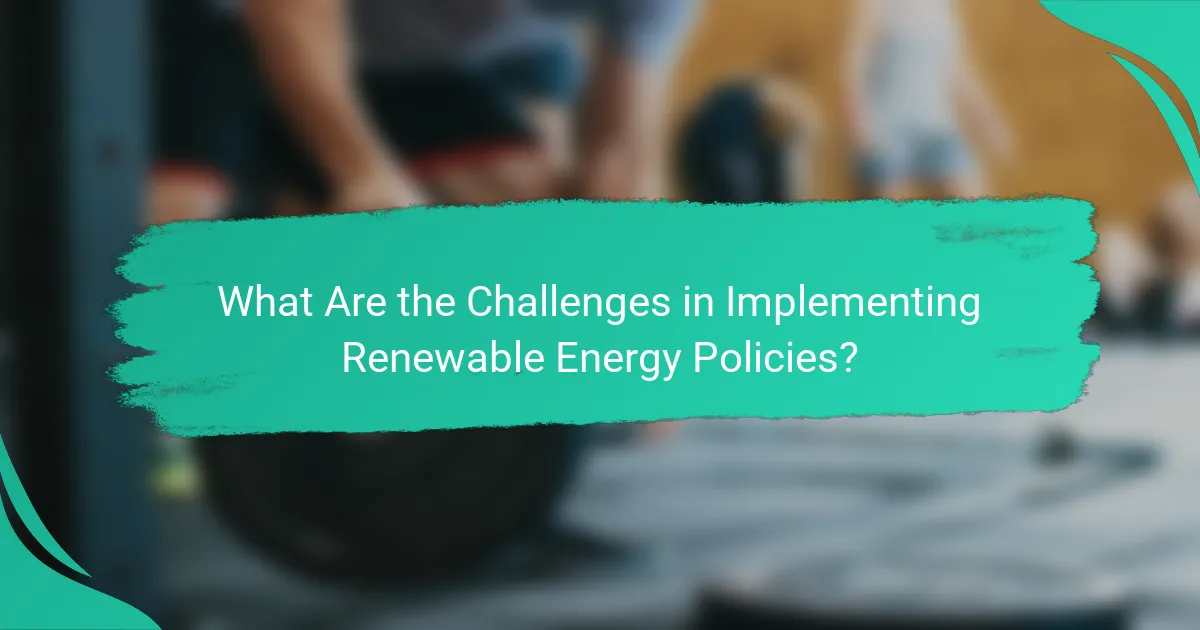
What Are the Challenges in Implementing Renewable Energy Policies?
Implementing renewable energy policies faces several challenges, including regulatory barriers, financial constraints, and technological limitations. These obstacles can hinder the effectiveness and adoption of sustainable energy solutions.
Regulatory Barriers
Regulatory barriers are a significant challenge in the implementation of renewable energy policies. These can include outdated laws, complex permitting processes, and inconsistent regulations across regions. Such hurdles can delay project approvals and increase costs for developers.
In many countries, the lack of a cohesive regulatory framework can lead to confusion among stakeholders. For instance, varying state or provincial regulations may create discrepancies in how renewable energy projects are managed, complicating compliance and increasing the risk of legal issues.
To navigate these barriers, stakeholders should engage in advocacy for clearer regulations and streamlined processes. Collaborating with local governments and industry groups can help identify specific regulatory challenges and work towards solutions that promote renewable energy development.
